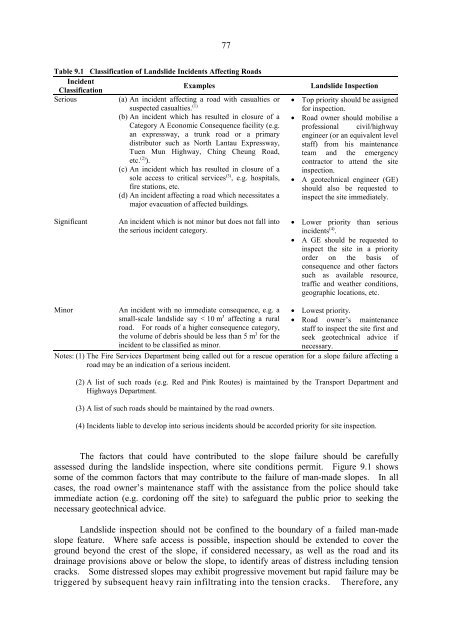Highway Slope Manual
Highway Slope Manual
Highway Slope Manual
Create successful ePaper yourself
Turn your PDF publications into a flip-book with our unique Google optimized e-Paper software.
77<br />
Table 9.1 Classification of Landslide Incidents Affecting Roads<br />
Incident<br />
Examples<br />
Classification<br />
Serious<br />
(a) An incident affecting a road with casualties or<br />
suspected casualties. (1)<br />
(b) An incident which has resulted in closure of a<br />
Category A Economic Consequence facility (e.g.<br />
an expressway, a trunk road or a primary<br />
distributor such as North Lantau Expressway,<br />
Tuen Mun <strong>Highway</strong>, Ching Cheung Road,<br />
etc. (2) ).<br />
(c) An incident which has resulted in closure of a<br />
sole access to critical services (3) , e.g. hospitals,<br />
fire stations, etc.<br />
(d) An incident affecting a road which necessitates a<br />
major evacuation of affected buildings.<br />
Landslide Inspection<br />
• Top priority should be assigned<br />
for inspection.<br />
• Road owner should mobilise a<br />
professional civil!highway<br />
engineer (or an equivalent level<br />
staff) from his maintenance<br />
team and the emergency<br />
contractor to attend the site<br />
inspection.<br />
• A geotechnical engineer (GE)<br />
should also be requested to<br />
inspect the site immediately.<br />
Significant<br />
An incident which is not minor but does not fall into<br />
the serious incident category.<br />
• Lower priority than serious<br />
incidents (4) .<br />
• A GE should be requested to<br />
inspect the site in a priority<br />
order on the basis of<br />
consequence and other factors<br />
such as available resource,<br />
traffic and weather conditions,<br />
geographic locations, etc.<br />
Minor<br />
An incident with no immediate consequence, e.g. a • Lowest priority.<br />
small-scale landslide say < 10 m 3 affecting a rural • Road owner, s maintenance<br />
road. For roads of a higher consequence category, staff to inspect the site first and<br />
the volume of debris should be less than 5 m 3 for the seek geotechnical advice if<br />
incident to be classified as minor.<br />
necessary.<br />
Notes: (1) The Fire Services Department being called out for a rescue operation for a slope failure affecting a<br />
road may be an indication of a serious incident.<br />
(2) A list of such roads (e.g. Red and Pink Routes) is maintained by the Transport Department and<br />
<strong>Highway</strong>s Department.<br />
(3) A list of such roads should be maintained by the road owners.<br />
(4) Incidents liable to develop into serious incidents should be accorded priority for site inspection.<br />
The factors that could have contributed to the slope failure should be carefully<br />
assessed during the landslide inspection, where site conditions permit. Figure 9.1 shows<br />
some of the common factors that may contribute to the failure of man-made slopes. In all<br />
cases, the road owner's maintenance staff with the assistance from the police should take<br />
immediate action (e.g. cordoning off the site) to safeguard the public prior to seeking the<br />
necessary geotechnical advice.<br />
Landslide inspection should not be confined to the boundary of a failed man-made<br />
slope feature. Where safe access is possible, inspection should be extended to cover the<br />
ground beyond the crest of the slope, if considered necessary, as well as the road and its<br />
drainage provisions above or below the slope, to identify areas of distress including tension<br />
cracks. Some distressed slopes may exhibit progressive movement but rapid failure may be<br />
triggered by subsequent heavy rain infiltrating into the tension cracks. Therefore, any

















